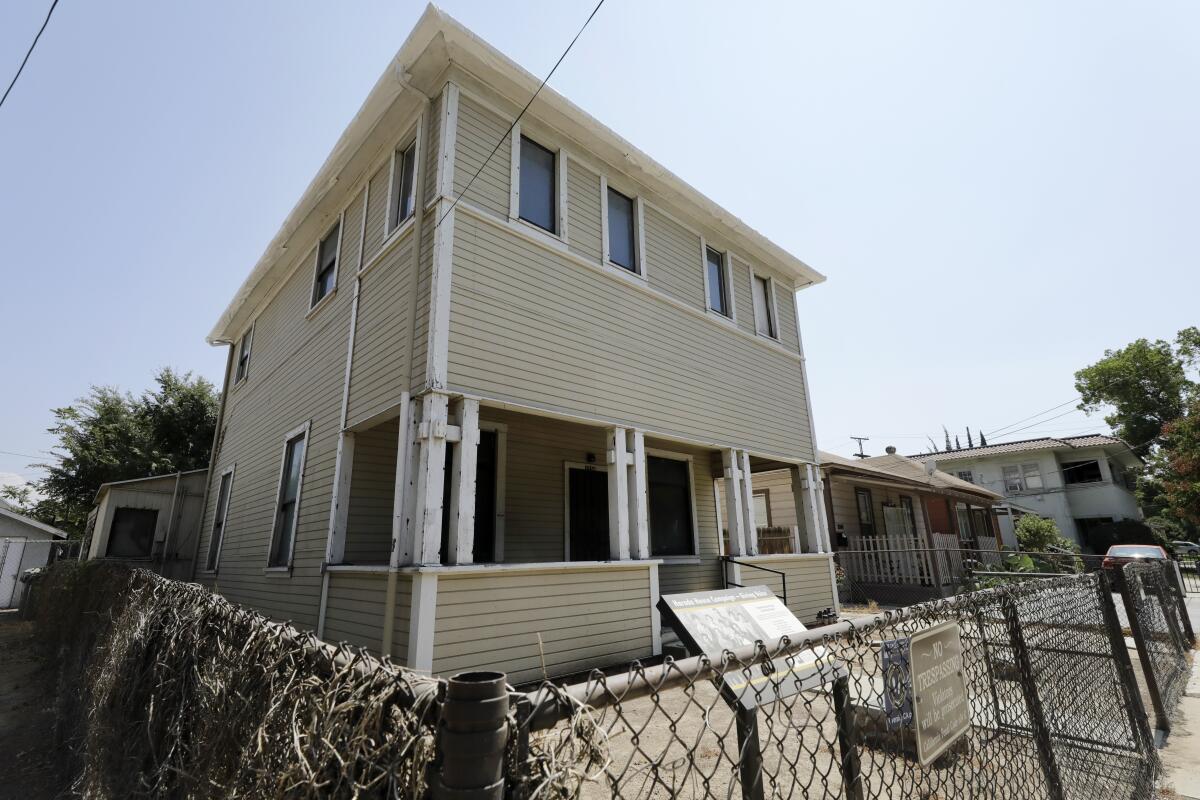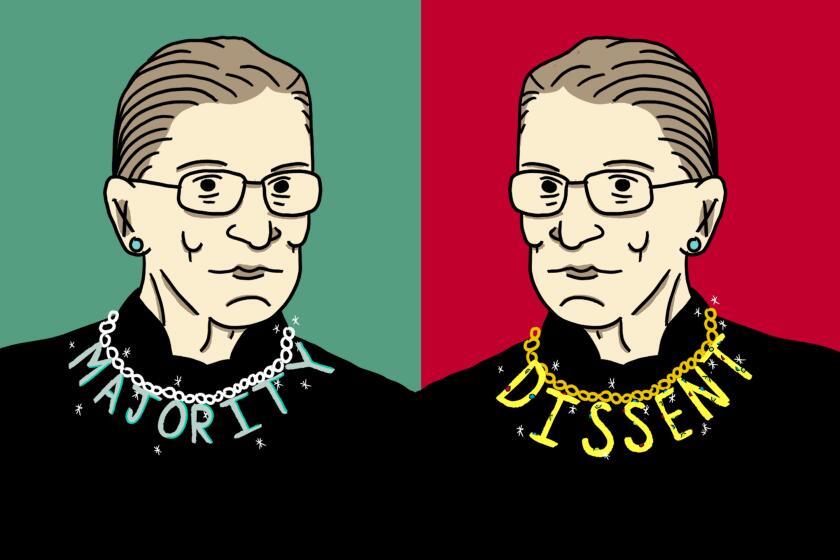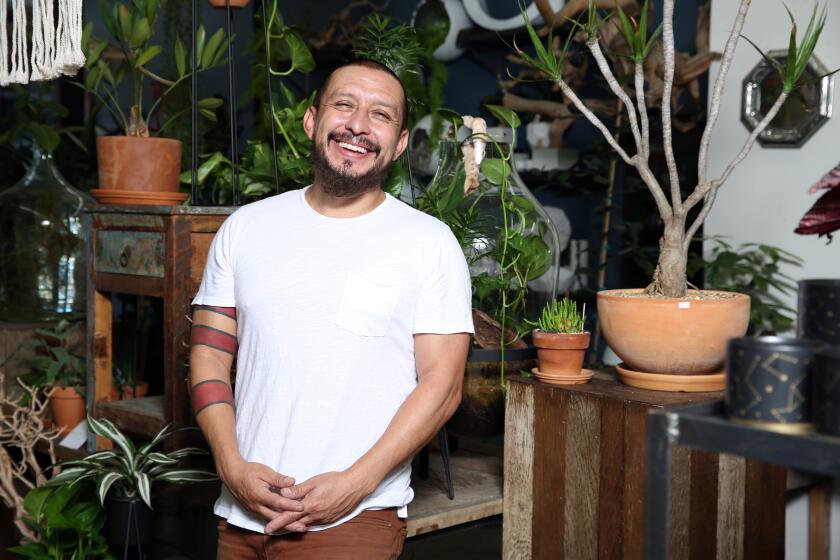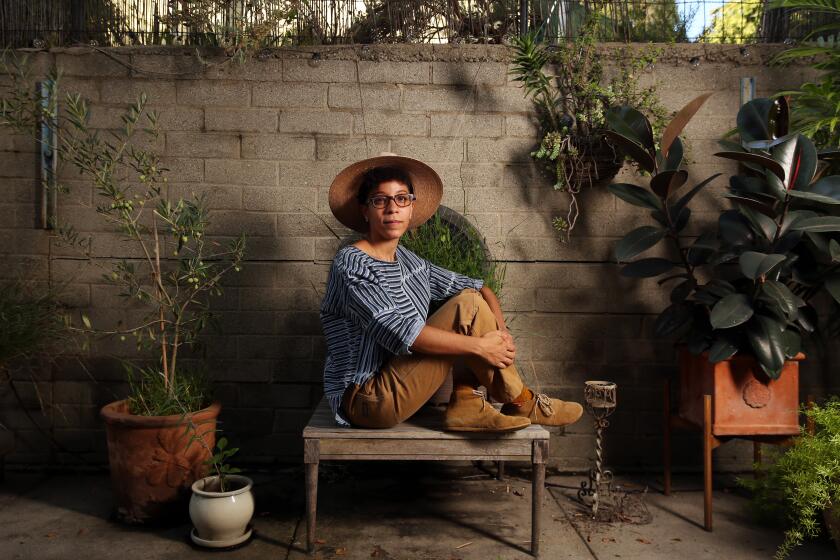This run-down home bore witness to racism against Asians. Now, it’s being protected

- Share via
Japanese immigrants Jukichi and Ken Harada were just looking for a healthier place to raise their family, after their 5-year-old son died from diphtheria in the crowded, dusty boarding house where they lived and took in immigrant farmworkers in 1913.
They found it in a modest box-shaped home on Lemon Street in one of Riverside’s nicest — and whitest — downtown neighborhoods. But Jukichi’s decision to buy the home in the names of their three American-born children — to circumvent California’s new Alien Land Law of 1913, which prohibited noncitizens, especially Asians, from owning property — created an uproar among their neighbors. It would all lead to a court battle that ultimately upheld the 14th Amendment citizenship rights of American children born to noncitizen parents.
Which is why today, this nondescript house in urgent need of repair was named one of the 11 Most Endangered Historic Places in the United States, a coveted designation by the National Trust for Historic Preservation that has only been awarded to 363 places in the country over the last 33 years.
The designation will go a long way to helping the Museum of Riverside raise the $6.5 million it needs to restore and preserve the home, as well as the smaller house next door that belonged to the woman who first raised the alarm about a Japanese family moving into the neighborhood, and years later became a grudging friend, said Museum Director Robyn Peterson.
What started out as a way to add feminine flair to judicial robes ended up speaking volumes.
But the good news for the museum started last month when the Harada House received a $500,000 grant from the Save America’s Treasures grant program, the only project in California to receive any funding from the $12.8 million distributed this year from the Historic Preservation Fund.
“We’ve had this home for 17 years and have only had enough money to keep it from falling down,” Peterson said. “Now we can start with the rehabilitation. Being one of the 11 means we’ll start getting some attention, nationally, and get on the radar screen of major funders for national historic projects.”
That’s the main reason the National Trust for Historic Preservation created this list, said the trust’s chief preservation officer, Katherine Malone-France. “This list is very much about the power of places to hold their stories and to evoke the people who lived in them while they were doing these extraordinary things,” she said.
‘I come from nothing.’ From cowboy to credit manager, Felix Navarro found his niche as a plantsman: The pandemic won’t slow him down.
“It’s not just about the story and facts of the past, but the story and how it relates to today. We’re constantly on the lookout for places that have important stories to tell, and certainly that is the case with Harada House. We’ve been doing this for 33 years, and I’m happy to say that less than 5% of the sites listed have been lost in that 33 years.”
As with most families, the Haradas’ story is laced with triumph and grief.
Their 1918 battle in Riverside County Superior Court was a landmark civil rights case for American-born children of immigrants, but Jukichi Harada, a successful businessman who ran a boarding house and restaurant named after his hero, George Washington, was never able to become an American citizen, despite his repeated efforts, according to a Aug. 18, 1991, article in The Times after Harada House was declared a National Historic Landmark.
During World War II, the family was forced into separate Japanese American incarceration camps. Before they left, their youngest son, Harold, scrawled a simple poignant message on the wall of the upstairs bedroom that is still faintly readable today: “Evacuated on May 23, 1942, SAT. 7 AM.”
The Harada parents died in one such camp — they were both in poor health when the incarceration began — and Harold went on to serve in Europe as part of the 442nd Infantry Regiment of American soldiers of Japanese ancestry. Most of the siblings moved to other parts of the country after the war, but Sumi Harada came back to live in her childhood home and provide housing for other displaced people of Japanese ancestry who had to rebuild their lives after the camps closed.
Congressman Mark Takano, a native of Riverside, remembers visiting Sumi Harada with his mother, Nancy, who was a family friend.
Takano (D-Riverside) said preserving the house helps us better understand the history and legacy of the Alien Land Act, which was strengthened after the Haradas won their court case and wasn’t repealed until 1951.
Jamie Renee Williams turned a tiny strip of dirt outside her apartment into an edible garden. You can tour it online during the LA Design Festival.
“For those who ask if there’s such a thing as institutional racism, I think we can point to this era and say, ‘Look, Japanese and other Asian immigrants had no pathway to citizenship, and persons ineligible for naturalization were prohibited from buying property, making it impossible for Japanese immigrants to buy land,” Takano said in a telephone interview.
“So, yes, this is curiously relevant to today, with all the anti-immigrant feeling and questions about who is an American and who is not. That message Harold wrote the day they were evacuated...that’s chilling, an amazing primary source of documentation of their internment.”
Naomi Harada, granddaughter of Jukichi and Ken Harada, called the house “a symbol of how our democracy works and supports our civil rights” in the museum’s news release.
“We learn from the stories of these symbols,” she said. “My hope is that the designation will bring an intense effort and financial support to keep the house from extinction. Just as the structure of the house is fragile, we are aware of democracy’s fragility. Maintaining and strengthening the symbols of our democratic processes ... assists in the acknowledgment and perpetuity of our civil rights.”
The other 10 locations listed on the 11 Most Endangered Historic Places are the the West Berkeley Shellmound and Village Site in Berkeley, a ceremonial ground and sacred burial site to the Ohlone people dating back more than 5,000 years, presently covered by a paved parking lot; Alazan-Apache Courts in San Antonio; the Hall of Waters in Excelsior Springs, Mo.; the National Negro Opera Company House in Pittsburgh; the Ponce Historic Zone in Ponce, Puerto Rico; Rassawek, the historical capital of the Monacan Indian Nation, in Columbia, Va.; Roberts Temple Church of God in Christ in Chicago; Sun-N-Sand Motor Hotel in Jackson, Miss.; Terrace Plaza Hotel in Cincinnati; and Yates Memorial Hospital in Ketchikan, Alaska. For more information about the 11 Most Endangered Historic Places list, visit the National Trust’s website, SavingPlaces.org.
More to Read
Sign up for The Wild
We’ll help you find the best places to hike, bike and run, as well as the perfect silent spots for meditation and yoga.
You may occasionally receive promotional content from the Los Angeles Times.














